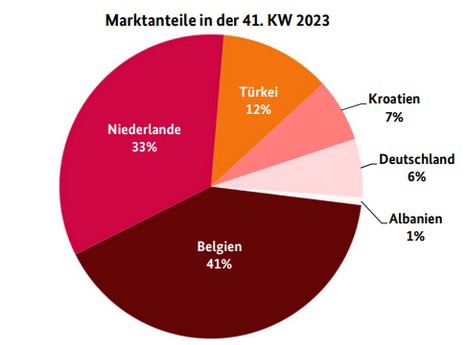Upward trending, in some cases very sharply rising, valuations characterized tomato transactions. The availability of the Belgian and Dutch batches had strongly limited due to the seasonal situation. Demand, on the other hand, was unbroken. According to the BLE, demand could, therefore, not be satisfied across the board. The markets unanimously reported rising prices.
In particular, the dominant lots from Belgium and the Netherlands became more expensive. However, customers also had to dig deeper into their pockets for complementary Italian and Turkish products as well as for Croatian, Polish, and Albanian imports. Even for domestic fruit, which was already quite highly-priced, traders were able to increase their demands once again.
Click here for the full market and price report.
Apples
The assortment was dominated by domestic offerings. Elstar, Jonagold, and Boskoop formed the basis, followed by Tenroy, Wellant, and Rubinette in terms of importance. The presence of Fuji expanded; they cost €1.40 per kg in Frankfurt, coming from the Alte Land.
 © BLE
© BLE
Pears
The presence of Italian deliveries apparently narrowed. Besides Santa Maria and Abate Fetel, Williams Christ and Carmen were also ready. From Turkey came Santa Maria. The importance of Dutch and Belgian unloading increased. German Conference, Xenia, Alexander Lucas, Gute Luise, and Gellert played quite an important role.
Table grapes
The European season was slowly entering the home stretch: The availability of Italian, French, and also Spanish offerings became increasingly limited. The supply of Turkish Sultana had also diminished. The limited supply met with equally reduced demand.
Lemons
South African imports still apparently predominated in the assortment. Turkish imports, however, had increased and were already playing a significant role locally. Complementary Spanish goods were now also increasingly handled in nets.
Bananas
A very quiet demand was met without difficulty. Only in Munich had accommodation improved somewhat. Here, quotations also rose somewhat for the entire range. Elsewhere, valuations remained constant.
Cauliflower
The assortment was changing: the domestic campaign was nearing its conclusion, and the availability of domestic supplies was shrinking noticeably. The first Italian deliveries arrived and joined the established Polish, Belgian, and Dutch products. Polish offloads, in particular, had noticeably increased.
Salads
Belgian and domestic deliveries were ready for iceberg lettuces, lettuces, variegated lettuces, and endives. In addition, Dutch lettuce and Spanish iceberg lettuce were also available. Overall, availability had expanded, with Spanish supplies in particular increasing.
Cucumbers
Spanish snake cucumbers now dominated, having displaced domestic supplies from the top position. The Dutch and Belgian lots were also ahead of the domestic items in terms of total volume. In general, prices tended to show a downward trend.
Sweet peppers
Dutch, Spanish, and Turkish unloadings formed the basis of the supply. Polish inflows completed the range of goods, and Belgian and domestic rounded it off. In general, availability was sufficient to meet demand. However, prices developed unevenly.
Source: BLE










